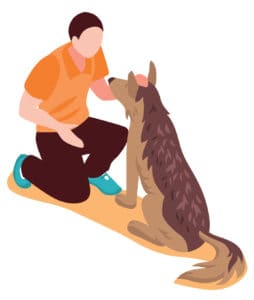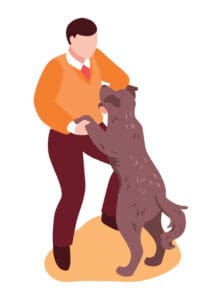Many dogs try to jump up when greeting people. Often, dogs receive attention for jumping up. Even if the dog is told “no!” or is pushed off, he is still receiving attention. That is why these methods do not work.
Why do dogs jump?
- Love of human contact.
- Not knowing what is appropriate in human body language.
- They may greet other dogs that way.
- They have been reinforced one way or another for this behavior
It is our job to teach our dogs how we would like them to greet us. The key to teaching your dog polite greetings is consistency. A good motto to remember is “four on the floor”. This simply means that all four feet should be on the floor when greeting. Even if someone insists, “It’s okay! I like dogs!” while your dog is jumping up to greet him or her, it is up to you not to allow this behavior. It can be difficult, but you must be firm with anyone who wants to make an exception to the rule of “four on the floor.” Equally important is teaching your dog an alternate behavior: a dog cannot jump on a person if the dog is sitting!
Getting Started
Here is what you will need to begin teaching your dog how to get attention without jumping on people:
- Your dog on a leash – this ensures that you are in control of the situation.
- One or two human assistants to help with greetings.
- High value treats to use as rewards.
- A training apron, treat. pouch or deep pockets, so that the food rewards are not in plain view.
The Game Plan
Begin by having the person helping you stand at a distance. Wait for your dog to check in with you. This means, at the bare minimum, making eye contact. If your dog reliably knows his or her name, you may say it ONE time (repeating anything will just teach your dog to ignore you). As soon as your dog looks at you, mark with a word or click from a clicker. Then reward your dog with a treat. Do this several times, until every time someone new appears, your dog is checking in with you.

Now that your dog is. checking in, allow the person to come closer. If at any time, your dog does not have four paws on the ground, have the person back up. If your dog is able to keep all four paws on the ground, be sure to praise them! Continue this until the person is able to approach your dog while all of your dog’s paws remain on the floor. Keep the leash loose and have the person put their hand out and low. Dogs explore things with their noses, so this is a great way to incorporate an alternative to jumping. As soon as the dog’s nose touches the hand, mark it with a click or a “YES!”. Reward your dog and have the person walk away.
As your dog gets better at this exercise:
- Practice in many locations.
- Add distractions that typically involve the jumping behavior such as: a knock at the door or doorbell ringing.
- Wait for your dog to also offer a sit or a down instead of just having four paws on the ground.
- Practice with many people.
- Increase the amount of time that the person is interacting with your dog.
- Randomize the number of treats. While you always want to use praise and a marker word, when the dog is consistently doing the right thing, you want to alternate how many rewards are given. Sometimes give just one treat, sometimes five treats, sometimes none. This keeps the dog always wanting more.
Helpful Hints
Remember, if your dog jumps, there is no need to correct them. Simply have the person back up. The lack of attention and contact from the person is a better way to teach your dog than a tug on the leash. It will keep training enjoyable!
What you reward, you reinforce. If you give your dog attention when he jumps on you, you are encouraging the behavior. You can also reinforce good behaviors by rewarding your dog any time the dog offers an ideal behavior, such as checking in with you, offering a sit or a down. This easy training can be done all day long. By rewarding your dog for choosing good behaviors, you are increasing the chance that they will begin to offer these desirable behaviors more frequently.
Small dogs and puppies may need the person to crouch down once they sit. From their point of view, it’s a long way up!
If you have a multidog household, it can be helpful to train one dog at a time. Sometimes the excitement of a new guest can cause normally well-behaved dogs to act out. Keeping the other dog(s) crated can make learning easier.
If your dog has a mat or bed that they go to, you can teach the dog to go to their mat or bed after greeting. Some dogs even learn to retreat to their area as soon as they hear a door knock. When they go to their bed or mat, you can reward them with a favorite toy or treat. Some dogs offer better greeting styles if they already have something in their mouths, such as a favorite rope toy, a ball, or a stuffed toy.




